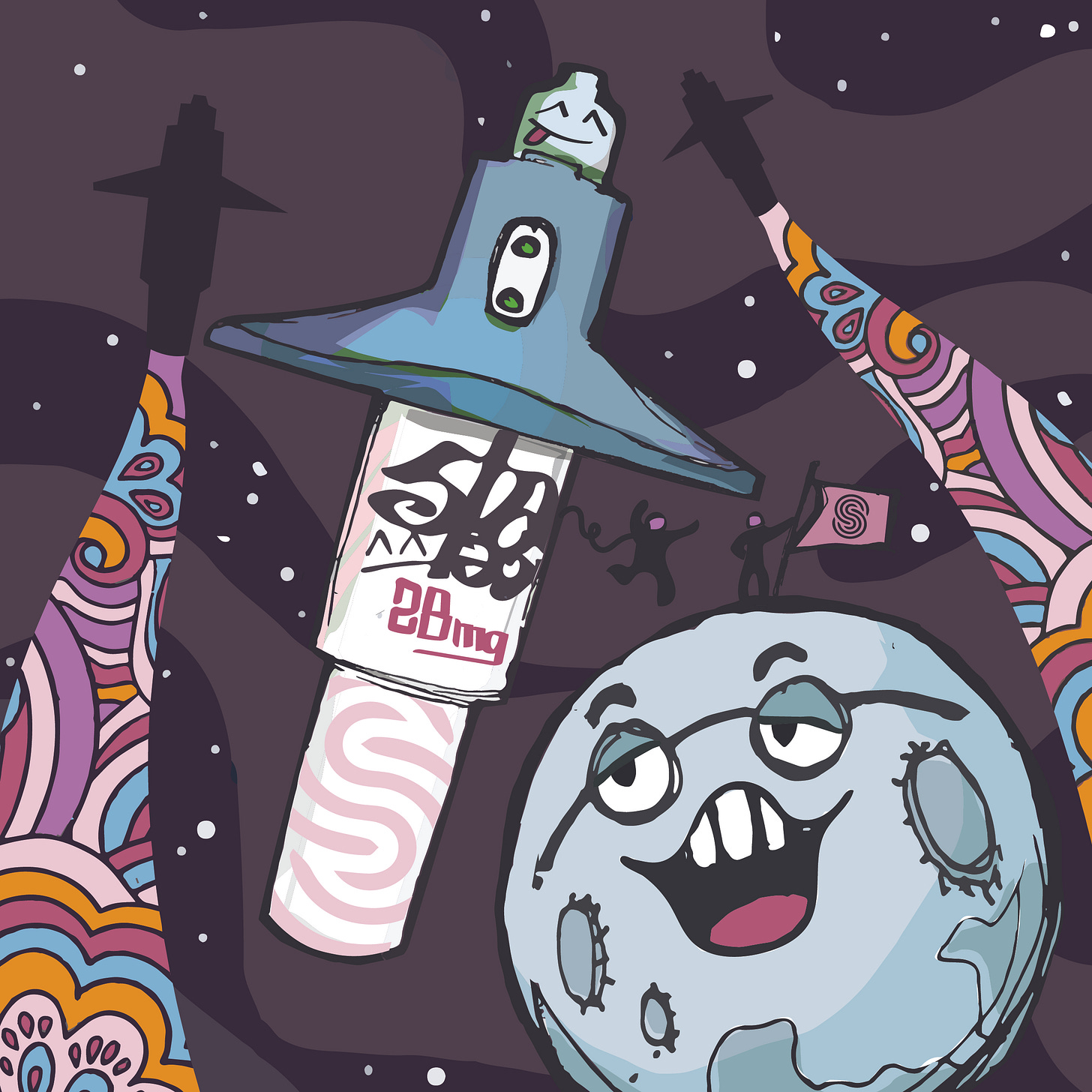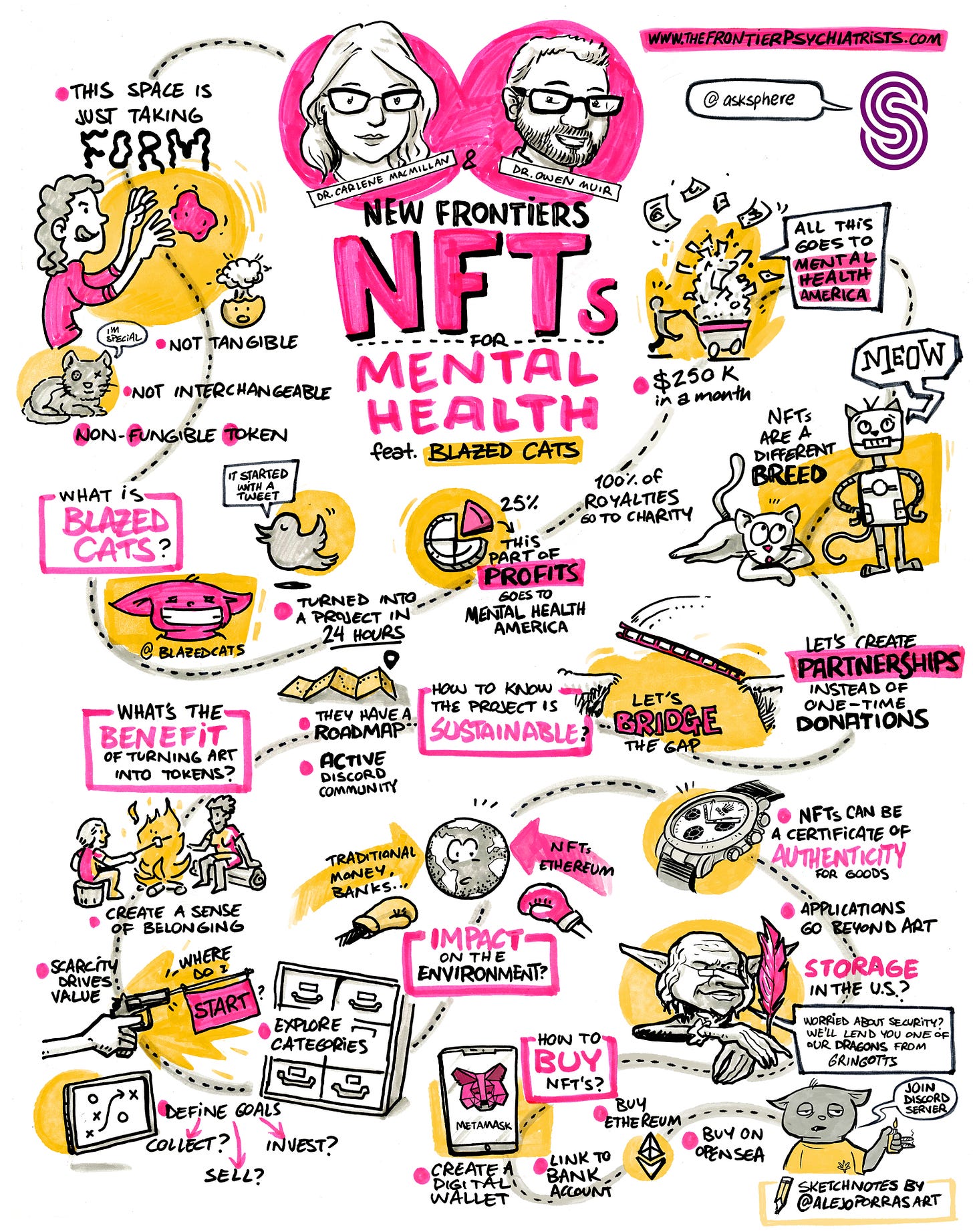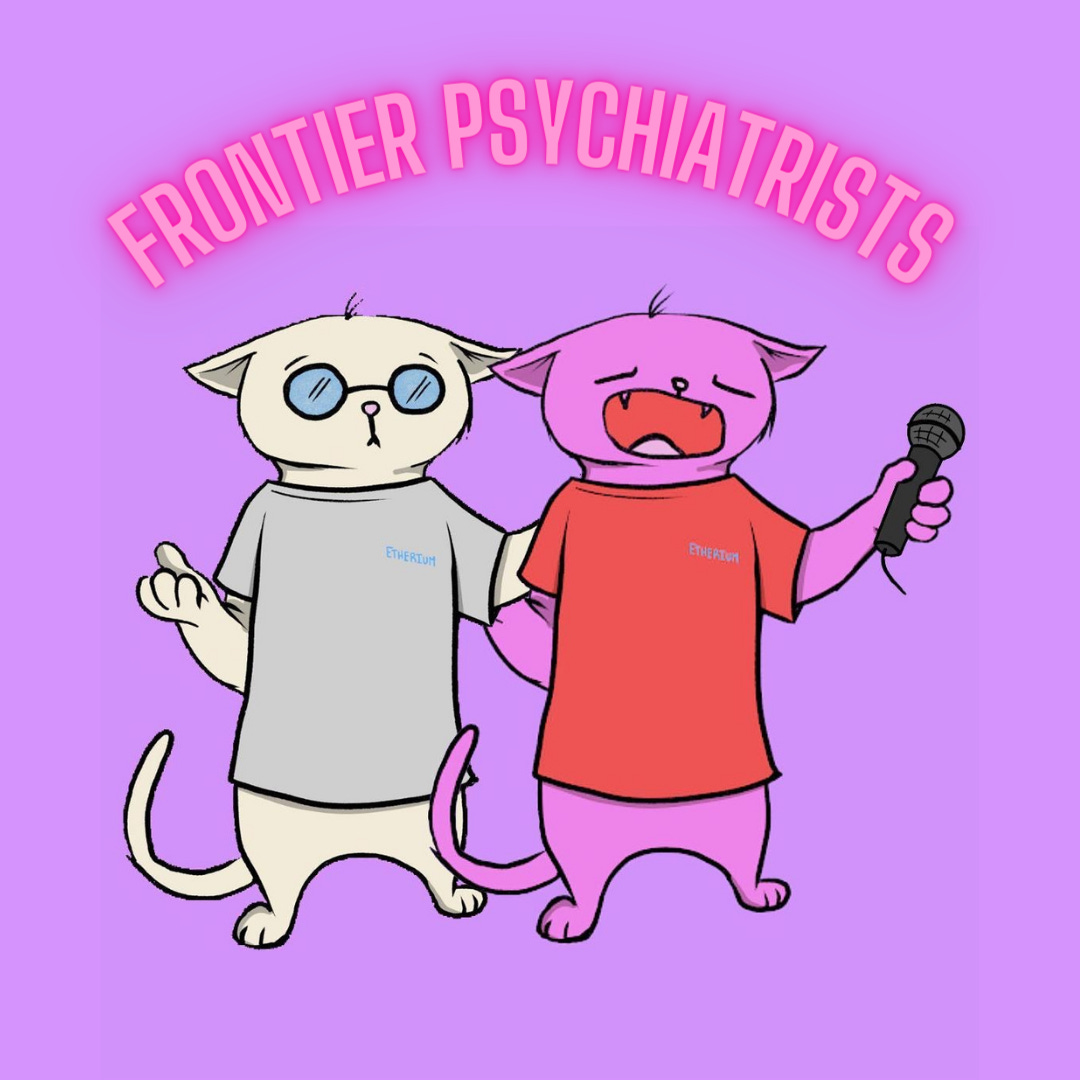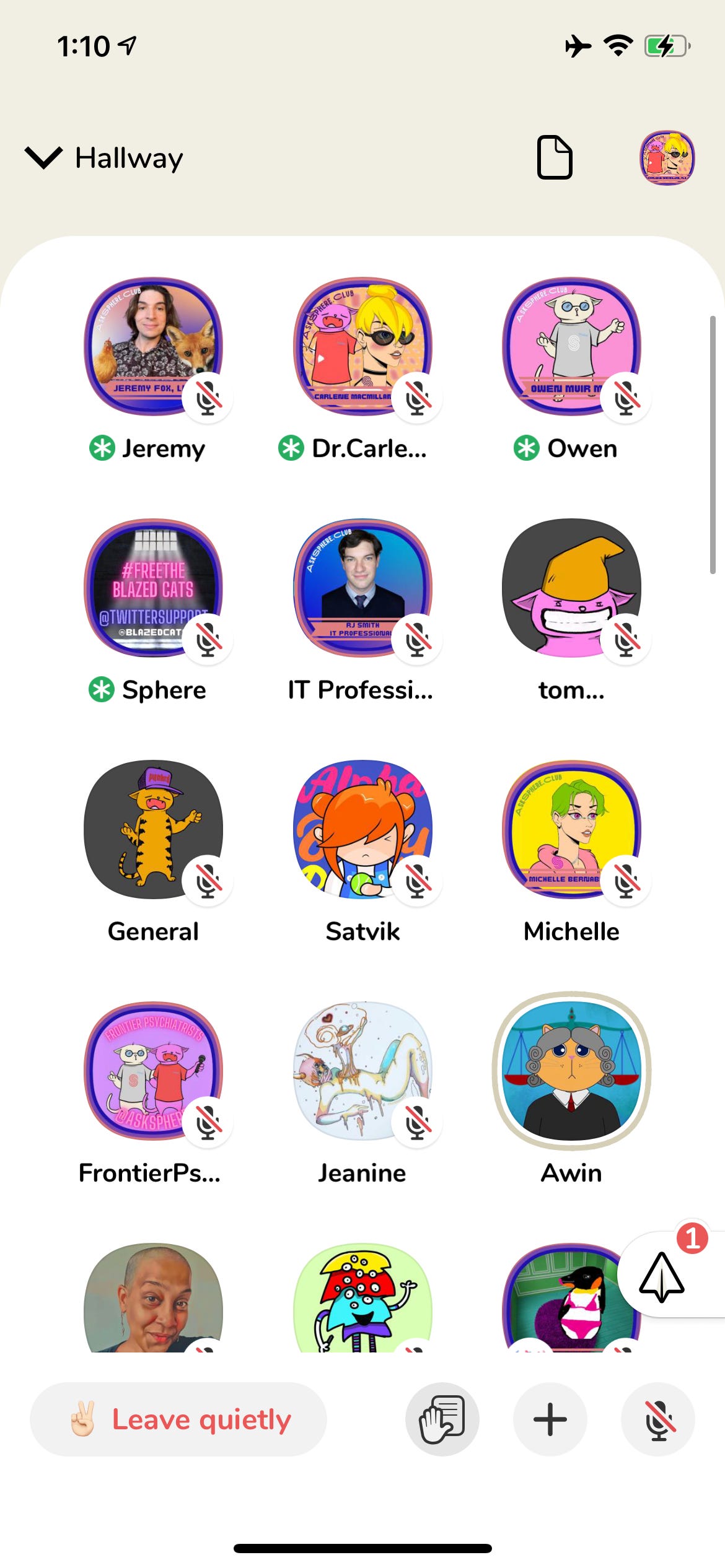Mental Health in the Metaverse
A Psychiatrist Reflects on Why NFT Projects like Blazed Cats are the perfect blend of community, creativity and charity.
When I got a message from a Twitter user who goes by “A Very Blazed Cat” offering to send a NFT of a JPEG of a tired looking pink cat wearing an Etherium T-shirt to my digital wallet, I felt as though I had found my tribe. If that last sentence does not read like something you’d expect to read from a Harvard-trained board-certified psychiatrist who just turned 40 and doesn’t smoke marijuana, I don’t blame you. However, hang in there with me as we journey into the metaverse today. Don’t know what the metaverse is? It is a buzzy term for the digital world we increasingly live in and everyone seems to have their own definition.
Several months ago, I thought NFTs- Non-Fungible Tokens- were “some weird art things that those crypto people like.” Now, I believe they represent endless possibilities when it comes to building online communities, establishing identities and transforming industries, including the mental health industry. Over the past several weeks, mainstream publications including the New Yorker and The New York Times, have started covering a type of NFT project known as a “generative avatar” project. Imagine if a group of kids trading baseball cards, tech nerds who like punk rock and the board of an elite country club got together and said, “hey let’s get into crypto” and you’d get a project like the Bored Ape Yacht Club. Put simply, these are 10,000 digital pictures of apes and each has a different combination of traits, some of which are more rare than others. Holding a Bored Ape- which originally cost 0.08 ETH- grants you access to a robust online community of fellow ape holders. ETH is Etherium, a type of cryptocurrency. At that time that much ETH was around $220 in U.S.Dollars. These apes now sell on a secondary market known as Open Sea for at least 15 ETH ($50,000) and usually a lot more. People change their profile pictures, aka avatars, across social media to their favorite generative NFT. Chances are if you spend any time on Twitter or Clubhouse, you have seen these profile pictures or pictures of other similar projects, often featuring animals.
Earlier this month, the NYTimes ran a piece with the headline ““I joined a Pudgy Penguin NFT Club Because Apparently That’s What We Do now. Is this what the Metaverse looks like?” While the article is a decent primer on the emerging NFT culture, this passage stood out to me:
Is there something morally indefensible about people buying and selling blockchain collectibles for many multiples of the median annual U.S. income? Probably, but at least they’re not hurting anyone. (Put it this way: One of the least harmful things I can imagine a young, mostly male group of extremely online people doing in their spare time is trading pictures of cartoon penguins.)

Blazed Cats- Show those Penguins the Way!
Alright, Blazed Cats, this is your time to shine (er...blaze)! What the NYTimes article misses is that there are more and more NFT projects appearing that are using the massive amount of ETH being spent to actually do good in the world. Blazed Cats caught my attention because in under 3 weeks since launching, they raised around a quarter of a million dollars for Mental Health America and are just getting started. The project came together in under 24 hours as a response to a That 70’s Show cast celebrity-led project called Stoner Cats that was widely criticized for being over-priced and had a number of technical difficulties upon launching. This irreverent, yet extremely well executed project has attracted the attention of the likes of mental health leaders like me. Even my professional organization, the American Academy of Child and Adolescent Psychiatry, ended up liking a tweet I made about the Blazed Cats. I am pretty sure this is the first NFT-related Tweet the organization has liked. Other academic physicians are starting to take notice as well- a child psychiatrist who has held leadership positions there and at the American Psychiatric Association messaged me the other day jokingly asking if I wanted to start a psychiatric practice in the metaverse with him. The thing is, I am not joking!
Right now, the Blazed Cat Projects is donating to Mental Health America because the community of “cat holders” voted on that particular charity. Another recent charitable project, Alpha Betty Doodles NFT, is organizing itself as a non-profit organization and has been donating proceeds to school teachers through a community grant program called DonorsChoose, giving teachers everything from pencil caddies to helping to remodel an auditorium. For people working NFT projects who want to incorporate a charitable element, Satvik Sethi, who helped on the Alpha Betty project, offers his services as a social impact consultant to strategize around sustainable long term plans. I think more and more NFT projects will include charitable giving as part of their roadmap. If a non-profit you know and love is looking to be considered, they should sign up with the Giving Block, an organization that helps non-profits accept cryptocurrency like Etherium.
Psychiatrists of the Metaverse

In our own practice, Brooklyn Minds, we have been accepting cryptocurrency for several years as we recognize for individuals like sex workers who are often excluded from traditional banking systems (and, come October, OnlyFans too), crypto offers a better alternative. However, since learning more about NFTs, the communities they are creating, and the potential they have to do good we have become increasingly interested in joining the party. To that end, the Frontier Psychiatrists have minted their very first NFT on the blockchain as part of a series we are calling “Drug Holiday.” We are starting with an illustration by therapist-artist Adam Ortiz, called Esketamine in Space. The starting price is the cost of one session of the actual drug, a cost which has been widely criticized since ketamine is a generic and much cheaper. However, given how FDA approvals work in the United States, Esketamine (Brand name Spravato) is actually much more widely accessible to people who use their insurance and cannot afford to pay privately for ketamine infusions, which run several thousand dollars. We have plans for a generative NFT project of our own focusing on generic medications with a much lower single price point but know to get these projects right and not have a Stoner Cats-esque mishap, we need the right team. We plan to have a portion of the proceeds donated to mental health charities and to a scholarship fund for individuals in our own practice who cannot afford to pay for the innovative service we offer. If you’d like to be involved and have the skills and experience, please get in touch with us! If there is one thing that can be said about the NFT world it is that it takes a village and teamwork is essential. That’s true of anything worth doing it seems like, including offering mental health that’s actually helpful!
But How Do You Actually Get a NFT?
As A Bonus I am including a brief primer on how to purchase your first NFT which we hope will be a Blazed Cat, an Alpha Betty or an NFT by one of our other guests from our recent show on Clubhouse (see list at end and links to their respective projects). If you spot any errors or it needs clarification, please let me know! There are other ways to do this but this is what I do and I hope it works for you!
You first need to set up a digital wallet and transfer money from your regular bank account into it as Ethereum. I use Coinbase since it is easy to use. I recommend transferring around $250 to start in order to get an entry level NFT from a reputable collection.
Download Metamask and set it up. This is also a Digital Wallet. I have not been able to add money directly into it in NY State but maybe in other states you can and don’t need a Coinbase wallet. I find it annoying I need two wallets but it’s worth it for those Cats!
Assuming you do need to transfer money from Coinbase to Metamask, copy your wallet address from Metamask and go into Coinbase and send ETH to that Metamask address. It should take a few minutes but should show up there soon!
Go on OpenSea (the directory where many NFT projects are listed after they have launched) and link your Metamask wallet so you can make purchases. I recommend doing this on a computer as it is a bit wonky on the phone. Navigate to the project you like (for example, here is Blazed Cats) and sort by price, low to high. If you see one for sale, go ahead and click to purchase. Keep in mind that there are “gas fees” associated with the cost of the transaction and these vary based on how busy the platform is at the time.
Once you have purchased the NFT, congratulations! Go forth and change your profile pic (“PFP”) to it on all your social platforms and join the associated Discord community. Usually on the project’s website there is a link to the Discord. I used to think Discord was just for gamers but now look forward to checking in regularly on the projects I “aped”into.
This is just the tip of the NFT iceberg but if you spend a little time on the Discord channels and start following some NFT people on Twitter (they are very friendly and most follow back!), you will be an old pro in no time and are “gmi” (aka gonna make it in crypto-speak). For a really awesome overview, NFTignition has done an amazing job laying it all out here.
This SNL sketch is not so bad as an explainer video either:
Clubhouse Mental Health Magic
We had a great conversation on NFTs for Mental Health on Clubhouse and want to highlight some of the projects of folks who participated:
Satvik Sethi @SatSethi14, satviksethi.com: Renowned mental health activist. Founder/CEO @Runaway_App. Creator @IndigoChildNFT. Social Impact Consultant. NFT enthusiast. Making the world happier
Lemny Perez (Dorje Gyaltso) @lem__ny, https://mobile.twitter.com/lem__ny Psychologist. Writer. NFT artist/collector. Buddhist. Columnist @latinostories Director of Global Healing @wearehealingtogether @lem_ny on Clubhouse & IG
Tom-@MisfitPieces, drapes.wtf, Co-Founder of @blazedcats | Creator of http://rug.wtf| Growth Engineer | Developer | Consultant
PlumLoves.eth, @Plumferno, /opensea.io/PlumPlumGeneral Plum (Admin) in @BlazedCats Discord *Your friendly Internet Mom reminding you to drink water and get enough sleep* /opensea.io/PlumPlum
rarible.com/plum
Carmen Aguirre @VjNeurite, linktr.ee/Neurite. (she/her) Animator and Creative Director. Carmen Is a medical student interested in child neurology and psychiatry. She works closely with the “Mind Deconstructed” non-profit. She has a collection of Emotions Monster NFTs and they even have their own Emotional Support Pets.
Jeanine Beverly: @epicthundercat linktr.ee/Epicthundercat
ENFP. Illustrator. NFT Artist! Psych Graduate. Creator of@NFTcreatures_ NEW DROPS:https://discord.gg/FTZyd9BNbY
Awin Tavakoli @TavakoliAwinhttps://mobile.twitter.com/TavakoliAwi#Lawyer and #Legal Trainer on a mission to make #law accessible and understandable for others international #Speaker #NFT enthusiast
Paid subscribers of our Substack will have access to the full audio of our show soon as well. Please consider subscribing to support our ongoing efforts to bring nuanced psychologically minded content to you on the regular! And do please email us at thefrontierpsychiatrists@spherehealth.co if you want to get involved in our NFT project on drug pricing and combatting pill-shaming.





